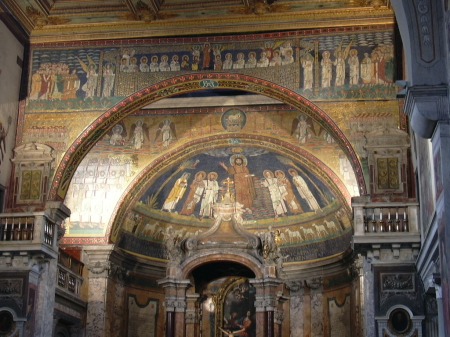And all the trees of the field shall know that I the Lord have brought down the high tree, have exalted the low tree, have dried up the green tree, and have made the dry to tree to flourish.
Ezekiel 17:24
 Petrus Christus, Madonna of the Dry Tree, c. 1465
Petrus Christus, Madonna of the Dry Tree, c. 1465
Oil on oak
Museo Thyssen-Bornemisza, Madrid
This diminutive painting, a mere 5 3/4 x 4 7/8 inches, makes an enormous impact. The iconography, unique in Netherlandish painting, has a magical quality—the Virgin and Child, standing in the fork of a barren tree, glow, jewel-like, against a dark background. Normally, in paintings of the period, Mary and Jesus are bathed in an all-encompassing Divine Light—here they shimmer in the shadows.
Flemish painter Petrus Christus (c. 1410/20-1472/75), born near Antwerp in Baerle-Duc (now Barrle-Hertog), was active in Bruges. The Madonna of the Dry Tree was likely commissioned for personal devotion by a wealthy member of the Confraternity of Our Lady of the Dry Tree, a group to which Christus and his wife belonged from 1450-1463.
There are so many interesting aspects to this tiny painting, symbolism abounds. The Tree of Knowledge, withered and dry after Adam and Eve ate of its fruit, comes to life through the Virgin. The Virgin, herself the miraculous product of the barren Anne, in turn gives birth via the Immaculate Conception. The dry tree presages the crown of thorns, representing Christ’s sacrifice for man’s redemption. Another fascinating element of this painting are the 15 golden ‘A’s that hang from the thorns of the tree. These represent Ave Maria, the Hail Mary prayer of the rosary. Ave is the reverse of Eva, or Eve—a reminder that Eve’s fall is redeemed through Mary, the new Eve, who is not only the mother of Christ but the intercessor for all mankind.
There are only about six paintings by Petrus Christus that are signed and accorded definitive attribution. Christus’ debt to his predecessors Jan van Eyck and Rogier van der Weyden is often cited, and perhaps he never did rise to their level of genius. Nonetheless, I find his works to have an intense, quiet charm and power—each one stamped with a unique sensibility that blazes across five hundred and fifty years of art history.
Wider Connections:
Petrus Christus: Renaissance Master of Bruges by Maryan W. Ainsworth


































































